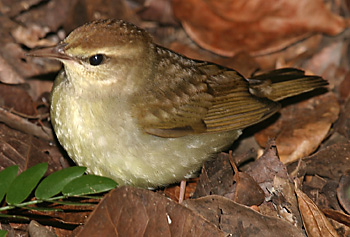 Carolina Parakeet, the now extinct native North American Psittacidae family member. From: http://farm3.static.flickr.com/2041/2334948993_3ee4befb53.jpg.
Carolina Parakeet, the now extinct native North American Psittacidae family member. From: http://farm3.static.flickr.com/2041/2334948993_3ee4befb53.jpg.
When people hear the name Audubon the first thing that pops into their minds is birds. This makes sense as John James Audubon himself was a prominent bird artist. I am a big fan of his art, and the society named after him (of course)! One thing that many may not know is that Audubon once wrote that “he felt incomplete if he didn’t kill a hundred birds a day” (Gibson 2005). Many of Audubon’s paintings were created using freshly killed models that were meticulously posed using wires to hold them in place. Sometimes it would take more than a hundred birds to find one perfect for his paintings (Gibson 2005). Audubon’s paintings were part of his “Birds of America,” which included 435 life-size paintings. For an interesting description of Audubon as an artist go here. Eventually Audubon began to worry about birds like the Carolina parakeet and the ivory-billed woodpecker, as he traveled the country painting, he encountered fewer of them. In “The Race to Save the Lord God Bird” an excerpt of Audubon’s diary mentions his concern remarking that it was popular to wear ivory-billed woodpecker bills and crests and that their habitat was being eliminated in many parts of the south. Finally, their loud calls and bright colors made them easy to find by hunters (Hoose 2004). Audubon himself actually had little to do with the creation or naming of the Audubon society. One of the Audubon Society’s founders, George Bird Grinnell, was tutored by Audubon’s wife. Knowing Audubon’s affinity for birds and his reputation as an ornithologist, Grinnell chose to name the society after Audubon (Audubon Society 2008). Swainson's warbler from: http://www.surfbirds.com/media/gallery_photos/20040419054308.jpg
Swainson's warbler from: http://www.surfbirds.com/media/gallery_photos/20040419054308.jpg
Another aspect of this time that negatively affected bird populations (aside from over-hunting, birds hats and a general lack of concern for nature) was museum collectors. Hoose recounts the actions of one man that while acceptable at the time, today are quite deplorable (and bewildering to me). George Beyer was a German born American museum-creator at Tulane University in New Orleans, LA. In 1899 ivory-billed woodpeckers were rarely, though not extinct. Beyer was informed that ivory-bills still existed and went on an expedition to bring skins back. While in LA he killed seven birds in a week (mind you they’re known to be rare at this time). Three of these birds were a family. The parents were still feeding their recently fledged baby when he killed them, cutting the next from its tree top home, so it could be part of the museum display (Hoose 2004). Arthur Wayne is another museum collector whose love of birds led him to become a hunter for museum collections. Wayne’s loved of birds was equaled by William Brewster, another museum collector. In 1884 Wayne and Brewster collected 47 swainson’s warblers, a species considered extinct until Wayne and Brewster “re-discovered” it (Hoose 2004).
Unfortunately I can’t find more information on this. I suppose I should check OSU’s library, though I’m not sure what else to search under. If I find more I’ll bring it too your attention at some point. Ultimately, my goal was to bring to light some bizarre, possibly previously un-thought of effects we have/had on birds. Birds have been popular ornamentation since man came into existence. Cave drawings depict birds, artists have painted them and people have committed their lives to studying birds. What gets me most about the “collecting” portion of our history is the “collecting” part of it. People who felt a true affinity for birds, a love for their plumage, their lives, killed them. In some cases these people helped wipe them out. I don’t get it. In 2000 I worked with a volunteer in Orange County, CA that originally brought this practice to my attention. We had caught a female calliope hummingbird in one of our nets. They’re a rare find in that area, so he brought her back to the banding station (mistake number one on his part). Once there he asked me if he could kill her, so she could be stuffed and placed in a natural history museum he worked for. I was horrified, why should she have to die? There are pictures of calliope hummingbirds. There are specimens in cases elsewhere for certain. It is all very odd. I got to work with some 50+ year old specimens last spring in Systematics of birds class. These specimens are spectacularly beautiful, and when will I ever see a typical roller in person again? They are also spectacularly sad. I held them in my hands knowing they had once breathed, cared for a family or been cared for and I cried.  Lilac-breasted roller from: http://www.davidmixner.com/images/2007/09/15/image002_2.jpg
Lilac-breasted roller from: http://www.davidmixner.com/images/2007/09/15/image002_2.jpg
Audubon Society. John James Audubon 1785-1851. 2008. Available at http://www.audubon.org/nas/jja.html. Accessed October 12, 2008.
Hoose, P. 2004. The Race to Save the Lord God Bird. Melanie Kroupa Books, New York. 196 pp.
Gibson, G. 2005. The Bedside Book of Birds. Nan A. Talese, New York. 369 pp.
Sunday, October 12, 2008
Ethno-ornithology Sunday: artists and collectors
Posted by Bird Wicks at 11:59 PM
Labels: ethno-ornithology
Subscribe to:
Post Comments (Atom)

3 comments:
All I CAN SAY IS UNREAL.WAS THE CAMARA NOT YET INVENTED? I love art to but lets face it most artist are way out there.very interesthing. peace
EXCUSE GRAMMAR.
good job...lots of work on a sunday love!!
Post a Comment